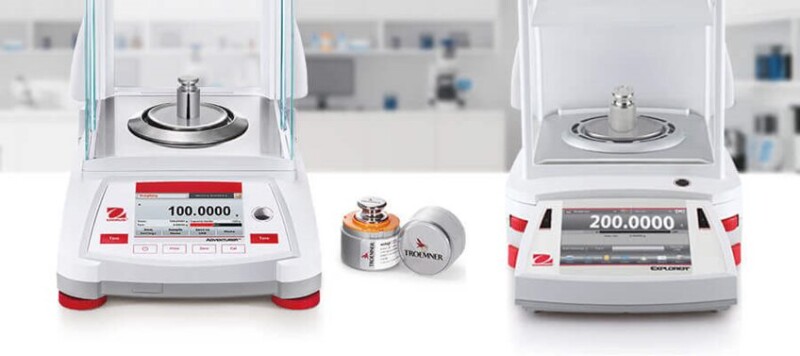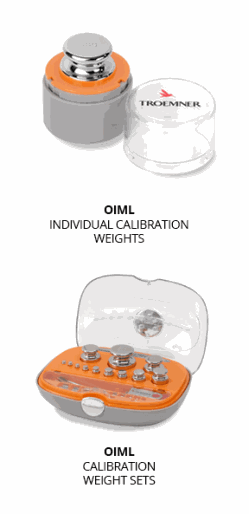Ohaus Corporation (United States) - OHAUS calibration weights and expert guidance help ensure dependable, long-term use.
Choosing the correct balance for your laboratory is very important, but understanding proper setup, usage, and maintenance is equally important.
At OHAUS we stand behind our products and appreciate that our customers have individual requirements for their laboratory. And so, we provide helpful guidance on how to maintain your laboratory balance to get the most consistent results and long-term use possible.
We encourage you to take the following steps to properly maintain lab balances to ensure peak performance and reliable accuracy.
Download OHAUS Laboratory Balance Instructional Manuals for further information found in this article:
Adventurer Laboratory Balances
Explorer Laboratory Balances
Pioneer Laboratory Balances
PR Series Laboratory Balances
Calibration and Adjustment:
To ensure consistent weighing results it is essential to perform regular calibration checks. Manual calibration can be done through easy-to-follow menu prompts on the display.
The steps to follow for manual calibration are rather simple. First, select calibration on the display menu. Second, place the weight on the weighing pan and verify the resulting readout is accurate. Third, make manual adjustments as needed.
Some balances come equipped with an internal calibration feature. A reference weight and motorized mechanism are built into the balance which relies on preset parameters to perform calibrations and calibration adjustments at the touch of a button.
Pioneer PX: Internal Calibration Video (see below).
Laboratory balances that feature an auto calibration function will perform a self-calibration (no intervention on the part of the user) when it senses a temperature change or based on a time interval.
A common question we get at OHAUS is, “How often do I need to calibrate my balance?” A balance needs to be calibrated upon initial setup and then anytime it is moved to another location. Beyond that, it depends on how often you use it and for what purposes. High resolution balances such as analytical balances may need to be calibrated more often than precision balances.
For quality control, laboratories should perform calibration according to their organization’s standard operating procedure or industry standard. In highly regulated industries such as pharmaceuticals, it may be necessary to perform daily calibration. A manufacturer may need to perform calibration on every work shift. In the jewelry industry the balance user may perform calibration before selling a product based on weight. In a university setting it may be necessary to calibrate between class experiments.
OHAUS offers a wide selection of calibration weight sets to suit your needs. Choose from individual calibration weights and sets that are adjusted to meet or exceed OIML class E1, E2, F1, and F2 tolerances. OHAUS calibration weights offer high accuracy with tight tolerances and uncertainties of less than 1/4 of the tolerance. Weights are offered in high grade stainless steels including Troemner Alloy 8 surfaces with highly polished finish.
Each weight offers a closely controlled density, extremely low magnetic properties, good stability, and resistance to corrosion. Each calibration weight is offered with certificate options traceable to NIST, including ISO/IEC 17025 accredited certification or traceable certification to aid in meeting SOP and regulatory requirements.
For highly-regulated industries like pharmaceuticals, it may be necessary to use certified weights.
Cleaning:
Keeping your balance clean is critical to any laboratory usage. Dust and debris can build up on the weighing pan and inside the weighing chamber over time. This can impact weighing results and hinder accuracy.
We recommended use a non-abrasive cloth like a lint-free microfiber towel to wipe down the weighing pan, inside of the weighing chamber and the glass draft shield. You may lightly dampen the cloth using a mild cleaning agent that is safe for use on stainless steel.
To properly clean the weighing pan, remove it, wipe it down, and then dry it completely before gently putting it back into place. Be careful not to allow any fluid or debris to get underneath the weighing pan and into the internal weighing mechanism as this can cause damage. Display screens and plastic components can be cleaned with a mild detergent.
Proper Use and Storage:
Be sure to follow proper usage guidelines to get the best results from your balance and ensure long product life. Anyone using the balance should be properly trained to never exceed the recommended weighing capacity, keep the balance away from dirty or dusty areas and store it properly. If the balance will not be used for a period of time, it’s a good idea to use a dust cover. Move the balance as infrequently as possible to avoid risk of dropping and when storing, take care not to place anything heavy or sharp on top of it.
A little extra care and thoughtful use will go a long way to ensuring the continuous use and long life of your laboratory balance.

























Interested? Submit your enquiry using the form below:
Only available for registered users. Sign In to your account or register here.